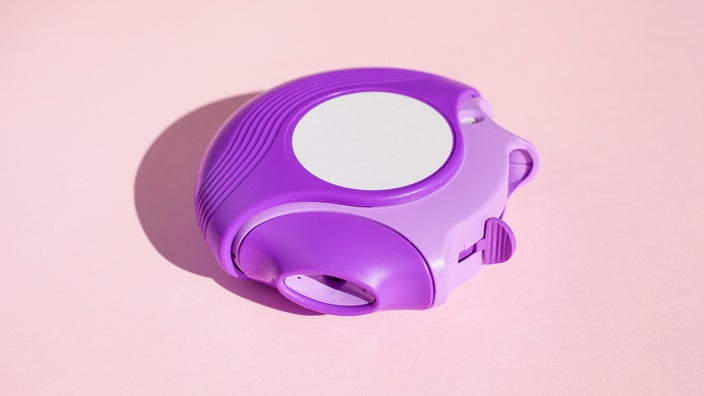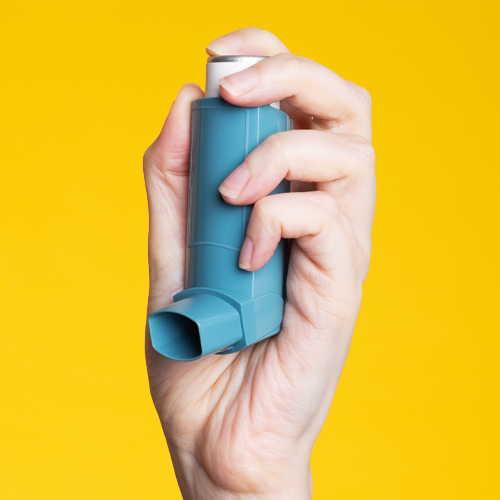
Dry Powder Inhalers: How to Use Them, Choose the Right Brand, and More
Key takeaways:
Dry powder inhalers (DPIs) are small handheld devices that let you breathe powdered medication into your lungs. They mainly treat health conditions that impact your breathing.
You must be able to take a deep, forceful breath for these devices to work. These inhalers may not be ideal for you if you can't inhale deeply.
There are several types of DPIs. Refer to the labeling that came with your DPI for specific instructions on how to use it.

If you have a respiratory condition, chances are you’ve used an inhaler to control your symptoms. Inhalers are small handheld medical devices that deliver medication into your lungs. They’re convenient tools you can carry around every day for maintaining and relieving breathing symptoms.
But if you’re familiar with inhalers, you may have wondered why they come in many shapes and sizes. That’s because they use different technologies to get medication into your lungs. Depending on your health condition and comfort using an inhaler, one may be a better fit for you than another.
One type of inhaler is called a dry powder inhaler (DPI). DPIs contain a sealed dose of powder medication, often in a capsule or disk. A DPI pierces the capsule or disk so you can breathe the powder into your lungs. These inhalers are breath-activated, meaning it will only release the medication when you take a deep, fast breath from the inhaler.
Here, we’ll discuss the DPIs that are currently available in the U.S.
What are dry powder inhalers (DPIs) used for?
Most FDA-approved DPIs are used to treat respiratory conditions, like asthma, chronic obstructive pulmonary disease (COPD), and cystic fibrosis.
But DPIs are also used for non-respiratory conditions. This is because certain medications can be absorbed into your bloodstream from the lungs. DPIs are currently approved to treat diabetes, Parkinson’s disease, and schizophrenia.
Read more like this
Explore these related articles, suggested for readers like you.
DPIs for migraines and COVID-19 are currently being studied.
What medications are available as a dry powder inhaler?
DPIs may contain one or more medications inside of them.
For instance, DPIs used for respiratory conditions typically contain a corticosteroid to reduce inflammation in the airways. But they may also have a bronchodilator to open up the airways. Most DPIs are intended to be used every day to prevent symptoms over time. The only DPIs approved as “rescue” inhalers for quick relief from symptoms are ProAir Digihaler and ProAir RespiClick.
Below, we’ll list the DPIs that are currently available and break them down by health condition.
| Health condition | Name of inhaler |
|---|---|
| Asthma and COPD |
|
| Cystic fibrosis |
|
| Diabetes |
|
| Flu |
|
| Parkinson’s disease |
|
| Schizophrenia |
|
Choosing the right dry powder inhaler product
Over the years, many types of DPIs have been approved. Each one has a different loading system. Some are single-dose, where you have to load the device with a capsule each time you use it. Others are multi-dose, where the device comes preloaded with multiple doses — typically a 30-day supply.
Here are the most common types of DPIs and their key features to know about:
| Type of DPI | Single-dose or multi-dose | Does it come preloaded with medication? | How to use |
|---|---|---|---|
| Digihaler | Multi-dose | Yes | Open the mouthpiece until you hear a click |
| Diskhaler | Multi-dose | No | Insert blister pack into the device tray |
| Diskus | Multi-dose | Yes | Slide a lever on the disc until it clicks |
| Dreamboat | Single-dose | No | Add cartridge to device |
| Ellipta | Multi-dose | Yes | Open the cover until you hear a click |
| Flexhaler | Multi-dose | Yes | Twist the inhaler tube one way, then again the opposite way |
| HandiHaler | Single-dose | No | Drop a single capsule into the device chamber |
| Inhub | Multi-dose | Yes | Slide a lever on the device until it clicks |
| Podhaler | Single-dose | No | Drop a single capsule into the device chamber |
| Pressair | Multi-dose | Yes | Press the button all the way down and release |
| RespiClick | Multi-dose | Yes | Open the mouthpiece until you hear a click |
| Staccato | Single-dose | Yes | No loading necessary |
| Twisthaler | Multi-dose | Yes | Twist the inhaler tube in a counterclockwise direction |
Keep in mind: Your healthcare provider will have to write a prescription for your inhaler. DPIs aren’t available over-the-counter. Choosing the right DPI should also be a shared decision between you and your healthcare provider. This decision should take into account your health conditions, insurance status, and personal preferences.
Is a dry powder inhaler different from a metered dose inhaler?
Yes, a DPI is different from a metered dose inhaler (MDI). MDIs contain liquid medication, but DPIs contain powder medication.
Metered dose inhaler
MDIs include a chemical propellant that pushes liquid medication out of the inhaler as a gas. It works like a spray can. But because the medication comes out as a gas, you have to inhale while you trigger the inhaler. This takes coordination, which can be tricky.
Fortunately, a device called a spacer can be used to help you use a MDI more easily. Spacers keep the medicated gas from your inhaler in a chamber until you breathe it all in.
Dry powder inhaler
DPIs are easier for some people to use than MDIs. For instance, you don’t have to coordinate when you inhale. Once the device is prepared, you inhale a deep breath of the powder when you’re ready. In fact, a study found that about 80% of MDI users prefer using a DPI inhaler due to ease of use.
DPIs don’t use a propellant. However, they often use powdered lactose as an inactive ingredient. If you’re sensitive to lactose, you may want to avoid DPIs.
How to use a dry powder inhaler
There are several types of DPIs, so there are minor differences between each product. But in general, you should follow these steps:
Remove any substances from your mouth.
Open the device’s cover or mouthpiece. Check your inhaler for debris. Wipe with a dry cloth if needed.
Load a dose of medicine (if needed for your DPI).
Stand or sit up straight.
Turn your head and hold the inhaler away from your mouth. Breathe out. Do not breathe into your inhaler.
Place the mouthpiece of the inhaler in your mouth. Close your lips around it and form a tight seal.
Inhale quickly and forcefully through your mouth. Remember not to breathe through your nose during this step.
Hold your breath and count to 10.
Remove the inhaler from your mouth and turn your head. Breathe out slowly. Repeat steps 3 to 8 if instructed by your healthcare provider.
When you finish, close the cover or mouthpiece.
If your inhaler contains a steroid, rinse your mouth with water and spit it out. Rinsing helps to prevent a mouth infection.
If you have a multi-dose device, check the dose counter number on the inhaler to see how many doses are left. The number will go down by one each time you use it.
Remember that the specific steps for using your DPI vary depending on the product. Be sure to read and follow the instructions that came with your medication’s labeling. You can also view videos on how to use different types of DPIs.
Common mistakes when using a dry powder inhaler
Taking care of your DPI is important. You’ll want to make sure your inhaler is always ready to go so you can use it when you need it.
Here are a few quick tips for using and taking care of your DPI:
Keep your inhaler closed when it’s not in use.
Always take a deep, quick breath. Otherwise, the full amount of medication may not reach your lungs.
Store your DPI in a cool, dry place. Do not store your DPI in the bathroom.
Do not use water to clean your DPI. This can clog it. Use a dry cloth to wipe the mouthpiece at least once a week.
Do not shake or breathe into your DPI.
If you have any questions about how to use and care for your DPI, talk with your healthcare provider or pharmacist.
The bottom line
A DPI is a device that allows you to breathe powder medication into your lungs. You have to take a deep, forceful breath to use these devices or the medication may not reach your lungs. There are many types of DPIs, so be sure to consult the package insert on how to use your specific inhaler. If you have any questions about your inhaler, talk to a pharmacist or healthcare provider.
Why trust our experts?



References
American Academy of Allergy, Asthma & Immunology. (n.d.). Dry powder inhalers defined.
Berkenfeld, K., et al. (2015). Devices for dry powder drug delivery to the lung. American Association of Pharmaceutical Scientists PharmSciTech.
Canadian Lung Association. (2016). How to use your inhaler.
DailyMed. (2020). ProAir Digihaler.
DailyMed. (2021). ProAir RespiClick.
Gardenhire, D. S., et al. (2017). A guide to aerosol delivery devices for respiratory therapists 4th edition. American Association for Respiratory Care.
Levy, M. L., et al. (2019). Understanding dry powder inhalers: Key technical and patient preference attributes. Advances in Therapy.
National Heart, Lung, and Blood Institute. (2021). How to use a dry powder inhaler.
Ramadan, W. H., et al. (2017). Patterns of use of dry powder inhalers versus pressurized metered-dose inhalers devices in adult patients with chronic obstructive pulmonary disease or asthma: An observational comparative study. Chronic Respiratory Disease.
Ye, Y., et al. (2022). The future of dry powder inhaled therapy: Promising or discouraging for systemic disorders? International Journal of Pharmaceutics.





























